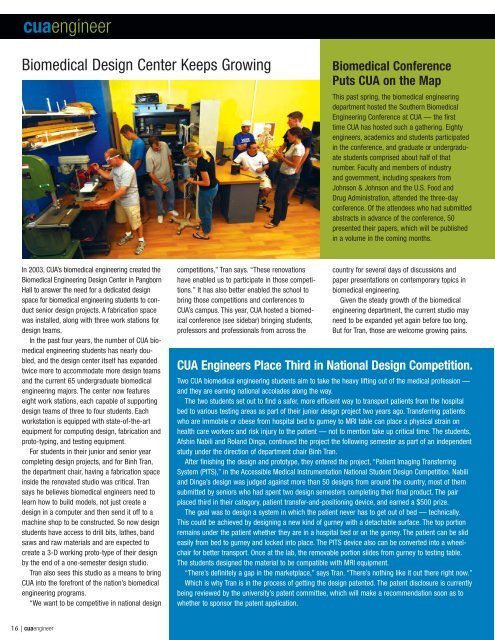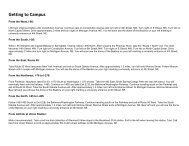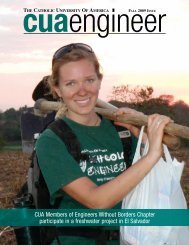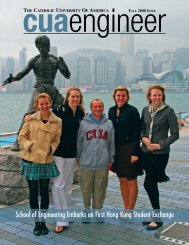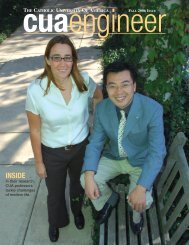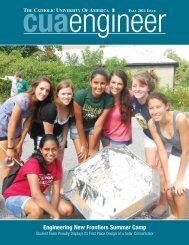the catholic university of america fall 2007 issue - the School of ...
the catholic university of america fall 2007 issue - the School of ...
the catholic university of america fall 2007 issue - the School of ...
- No tags were found...
You also want an ePaper? Increase the reach of your titles
YUMPU automatically turns print PDFs into web optimized ePapers that Google loves.
cuaengineerBiomedical Design Center Keeps GrowingBiomedical ConferencePuts CUA on <strong>the</strong> MapThis past spring, <strong>the</strong> biomedical engineeringdepartment hosted <strong>the</strong> Sou<strong>the</strong>rn BiomedicalEngineering Conference at CUA — <strong>the</strong> firsttime CUA has hosted such a ga<strong>the</strong>ring. Eightyengineers, academics and students participatedin <strong>the</strong> conference, and graduate or undergraduatestudents comprised about half <strong>of</strong> thatnumber. Faculty and members <strong>of</strong> industryand government, including speakers fromJohnson & Johnson and <strong>the</strong> U.S. Food andDrug Administration, attended <strong>the</strong> three-dayconference. Of <strong>the</strong> attendees who had submittedabstracts in advance <strong>of</strong> <strong>the</strong> conference, 50presented <strong>the</strong>ir papers, which will be publishedin a volume in <strong>the</strong> coming months.In 2003, CUA’s biomedical engineering created <strong>the</strong>Biomedical Engineering Design Center in PangbornHall to answer <strong>the</strong> need for a dedicated designspace for biomedical engineering students to conductsenior design projects. A fabrication spacewas installed, along with three work stations fordesign teams.In <strong>the</strong> past four years, <strong>the</strong> number <strong>of</strong> CUA biomedicalengineering students has nearly doubled,and <strong>the</strong> design center itself has expandedtwice more to accommodate more design teamsand <strong>the</strong> current 65 undergraduate biomedicalengineering majors. The center now featureseight work stations, each capable <strong>of</strong> supportingdesign teams <strong>of</strong> three to four students. Eachworkstation is equipped with state-<strong>of</strong>-<strong>the</strong>-artequipment for computing design, fabrication andproto-typing, and testing equipment.For students in <strong>the</strong>ir junior and senior yearcompleting design projects, and for Binh Tran,<strong>the</strong> department chair, having a fabrication spaceinside <strong>the</strong> renovated studio was critical. Transays he believes biomedical engineers need tolearn how to build models, not just create adesign in a computer and <strong>the</strong>n send it <strong>of</strong>f to amachine shop to be constructed. So now designstudents have access to drill bits, la<strong>the</strong>s, bandsaws and raw materials and are expected tocreate a 3-D working proto-type <strong>of</strong> <strong>the</strong>ir designby <strong>the</strong> end <strong>of</strong> a one-semester design studio.Tran also sees this studio as a means to bringCUA into <strong>the</strong> forefront <strong>of</strong> <strong>the</strong> nation’s biomedicalengineering programs.“We want to be competitive in national designcompetitions,” Tran says. “These renovationshave enabled us to participate in those competitions.”It has also better enabled <strong>the</strong> school tobring those competitions and conferences toCUA’s campus. This year, CUA hosted a biomedicalconference (see sidebar) bringing students,pr<strong>of</strong>essors and pr<strong>of</strong>essionals from across <strong>the</strong>country for several days <strong>of</strong> discussions andpaper presentations on contemporary topics inbiomedical engineering.Given <strong>the</strong> steady growth <strong>of</strong> <strong>the</strong> biomedicalengineering department, <strong>the</strong> current studio mayneed to be expanded yet again before too long.But for Tran, those are welcome growing pains.CUA Engineers Place Third in National Design Competition.Two CUA biomedical engineering students aim to take <strong>the</strong> heavy lifting out <strong>of</strong> <strong>the</strong> medical pr<strong>of</strong>ession —and <strong>the</strong>y are earning national accolades along <strong>the</strong> way.The two students set out to find a safer, more efficient way to transport patients from <strong>the</strong> hospitalbed to various testing areas as part <strong>of</strong> <strong>the</strong>ir junior design project two years ago. Transferring patientswho are immobile or obese from hospital bed to gurney to MRI table can place a physical strain onhealth care workers and risk injury to <strong>the</strong> patient — not to mention take up critical time. The students,Afshin Nabili and Roland Dinga, continued <strong>the</strong> project <strong>the</strong> following semester as part <strong>of</strong> an independentstudy under <strong>the</strong> direction <strong>of</strong> department chair Binh Tran.After finishing <strong>the</strong> design and prototype, <strong>the</strong>y entered <strong>the</strong> project, “Patient Imaging TransferringSystem (PITS),” in <strong>the</strong> Accessible Medical Instrumentation National Student Design Competition. Nabiliand Dinga’s design was judged against more than 50 designs from around <strong>the</strong> country, most <strong>of</strong> <strong>the</strong>msubmitted by seniors who had spent two design semesters completing <strong>the</strong>ir final product. The pairplaced third in <strong>the</strong>ir category, patient transfer-and-positioning device, and earned a $500 prize.The goal was to design a system in which <strong>the</strong> patient never has to get out <strong>of</strong> bed — technically.This could be achieved by designing a new kind <strong>of</strong> gurney with a detachable surface. The top portionremains under <strong>the</strong> patient whe<strong>the</strong>r <strong>the</strong>y are in a hospital bed or on <strong>the</strong> gurney. The patient can be slideasily from bed to gurney and locked into place. The PITS device also can be converted into a wheelchairfor better transport. Once at <strong>the</strong> lab, <strong>the</strong> removable portion slides from gurney to testing table.The students designed <strong>the</strong> material to be compatible with MRI equipment.“There’s definitely a gap in <strong>the</strong> marketplace,” says Tran. “There’s nothing like it out <strong>the</strong>re right now.”Which is why Tran is in <strong>the</strong> process <strong>of</strong> getting <strong>the</strong> design patented. The patent disclosure is currentlybeing reviewed by <strong>the</strong> <strong>university</strong>’s patent committee, which will make a recommendation soon as towhe<strong>the</strong>r to sponsor <strong>the</strong> patent application.16 | cuaengineer


